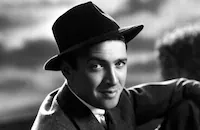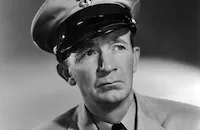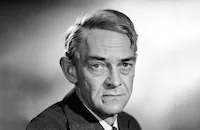The Far Country

Brief Synopsis
Cast & Crew
Anthony Mann
James Stewart
Ruth Roman
Corinne Calvet
Walter Brennan
John Mcintire
Film Details
Technical Specs

Synopsis
In 1896, cattle driver Jeff Webster arrives in Seattle and greets his partner, good-natured Ben Tatum. With Jeff is the herd he has driven across the country, and two cowboys, who have been tied up for attempting to steal steers. Although Jeff killed their cohorts in self-defense, he lets the two hands go free. Jeff and Ben then board a paddleboat heading for Skagway, Alaska, where they plan to sell the herd. Just as the boat leaves the dock, however, the two hands show up with the sheriff to arrest Jeff for killing the cowboys, and Capt. Benson promises to lock Jeff up and have him arrested upon returning. Hearing this, Jeff flees the captain's men, escaping into the cabin of Ronda Castle, who saves him by pretending he is her lover. Ronda, who tells Jeff she may soon need a friend herself, hides him for the rest of the trip, but as soon as they reach Skagway, more trouble awaits. Jeff avoids an unfair cattle tariff by driving the herd through the streets, interrupting a hanging presided over by crooked politician Gannon. Upon learning that Jeff is wanted for murder, Gannon calls an impromptu trial in the local saloon, which Ronda owns. Gannon hears "testimony" over a bottle of gin, then acquits Jeff, but seizes his cattle for disturbing the peace. Later, Jeff witnesses more of Gannon's genially corrupt practices, and turns down his offer to serve as deputy. When Ronda asks him to transport her supplies to her new saloon in the gold rush settlement of Dawson, however, he accepts, knowing that Gannon is having Jeff's cattle transported in the same trip. That night, he meets Renee Vallon, a French Canadian who, in order to send her father to school, collects gold dust spilled on the saloon floor by gold miners. Although Renee is smitten with Jeff, he dismissively refers to the young woman as "Freckle Face." The next morning, Jeff, Ben and their drunken friend Rube set out, along with Ronda and her workers. As soon as everyone is asleep that night, Jeff instructs Ben and Rube to round up the cattle, and Renee spots them as they head back to Skagway. When Gannon hears about the ruse and pursues them, Jeff rushes to cross the Canadian border, where Gannon's jurisdiction ends. Gannon laughs at Jeff's cleverness but swears to hang him as soon as the harsh winter weather begins and forces him to return via Skagway. When Jeff rejoins his group, he finds Renee among them, to his chagrin. While talking along the trail, he warns her never to trust others. The group soon finds Ronda, who, knowing Jeff can lead her team through the rough country, agrees to go along with him. Soon after, however, she ignores his instructions to take a longer route around the snow-capped mountains, and is hit by an avalanche. Although Jeff at first does not want to turn back to rescue her group, Ben and Renee insist, and that night, Renee watches jealously as a grateful Ronda wraps Jeff in a kiss. After arriving in Dawson, Jeff allows Ronda to outbid locals Hominy, Grits, Luke and Dusty for his cattle, and Hominy's restaurant customers flock to Ronda's saloon. Jeff then buys a land claim and begins working it feverishly, and within weeks he has sacks of gold. Ignoring the news that several gold rushers have been killed while trying to leave town, Jeff learns of a trail he can take that avoids Skagway, and prepares to leave Dawson behind. That night at the saloon, after two more dead bodies are brought in, the citizens discuss their need for a sheriff. They urge Jeff to accept the post, but when he refuses, they choose Rube. Soon after, Gannon appears in town, and his men immediately begin to usurp the locals' land claims. When one of them shoots Dusty, Rube tries to stand up to him, and Jeff, seeing Rube outnumbered, takes Gannon's side. Although the older man's life is saved, his pride is mortally wounded, and soon he is drinking ceaselessly. Jeff informs Ben they will leave that night, but when Ben inadvertently tips off Gannon's men, they are followed to the river. There, Ben is killed, while Jeff is shot twice and their gold stolen. Jeff barely makes it back to town, and only Renee will bother to help him. Days later, an abashed Jeff asks Renee why she would bother ministering to him, and she retorts that people must help others in need. When Ronda visits to notify Jeff that Gannon was behind the attack, she asks him to go away with her, but he demurs. Over the next few days, Jeff, whose shooting hand is still injured, witnesses Gannon's men terrorizing the town. Worn down, the citizens decide to leave town. When Jeff urges them to stay and fight, they spurn him. Furious at his helplessness, he tears off his bandage and straps on a gun. In the street outside the saloon, Jeff kills two of Gannon's henchmen, and then calls out for Gannon. When Ronda, afraid for Jeff's safety, runs into the street, Gannon shoots her and then turns his guns on Jeff. In the ensuing gunfight, Gannon shoots Jeff in the leg, but Jeff finally kills his nemesis. Gannon's men begin to file out of the saloon menacingly, but stop short. Jeff turns to see Rube leading the townspeople, their guns raised, toward the saloon. After the beaten outlaws flee, Renee races to support Jeff and he embraces her.

Director

Anthony Mann
Cast

James Stewart

Ruth Roman

Corinne Calvet

Walter Brennan

John Mcintire

Jay C. Flippen

Henry Morgan

Steve Brodie

Connie Gilchrist

Robert Wilke
Chubby Johnson

Royal Dano
Jack Elam

Kathleen Freeman
Connie Van
Guy Wilkerson

Gregg Barton
Eddy C. Waller
Stuart Randall
Chuck Roberson
Jack Williams
William J. Williams
Allan Ray
Eugene Borden

John Doucette
Robert Foulk
Paul Bryar
Damian O'flynn
Terry Frost
Edwin Parker
Don Harvey
John Halloran
Gina Holland
Marjorie Stapp
Carl Harbaugh
Robert Bice
Paul Savage
James W. Horan
Gerald Baril
Ted Kemp
John Mackin
Dick Taylor
Dick Dickinson
Ted Mapes
Len Mcdonald
Jack Dixon
Angeline Engler
Charles Sweetlove
Andy Brennan
Crew
Leslie I. Carey
Borden Chase
Ray Craddock
Oliver Emert
Bruno Engler
William Fritzsche
Russell A. Gausman
Joseph Gershenson
Alexander Golitzen
Ben Hendricks
Bernard Herzbrun
Jay Morley Jr.
Robert Pritchard
Aaron Rosenberg
Russell Schoengarth
John Sherwood
Joan St. Oegger
Bud Westmore

Photo Collections
Videos
Movie Clip



Trailer
Hosted Intro



Film Details
Technical Specs

Articles
The Far Country
The Far Country (1955) was the fourth Western Stewart and Mann made together, all of which were significant to the actor's later career. Stewart had been making pictures since 1935, building an image as the amiable, sometimes flustered but good-natured All-American guy, the kind of simple, down-to-earth man who could turn the head of haughty heiress Katharine Hepburn in The Philadelphia Story (1940), for which he won a Best Actor Oscar, or turn Congress on its ear with a plea for forthright values in Frank Capra's Mr. Smith Goes to Washington (1939). He was an immensely likable and popular leading man, whose success was further enhanced by his distinguished record in World War II. But by the end of the war, a new Stewart was ready to emerge. Capra first tapped the potential in It's a Wonderful Life (1946), now considered an uplifting holiday classic but a story that plumbs the lurking darkness behind sunny small-town American life.
Stewart revealed an unexpected intensity in his first film with Mann, Winchester '73 (1950). Shortly after, he struck a particularly sweet deal (and rather innovative for its time) with Universal in which he received a percentage of his films' profits. This allowed him greater risk and freedom and made possible the string of movies he would make with Mann, including Bend of the River (1952), Thunder Bay (1953), The Glenn Miller Story (1954), The Man from Laramie (1955), Strategic Air Command (1955) and The Far Country. The two made one other film together - The Naked Spur (1953) - an MGM picture that nevertheless fit perfectly with the Universal series. In the course of these movies, especially the Westerns, Stewart established the new range that would carry him through the decade, not only with Mann but with Alfred Hitchcock, most notably in Vertigo (1958) - that of a tougher, less open man, one who revealed levels of pain, mistrust, and near-hysteria that would have been unthinkable for the Stewart of 20 years earlier.
With Stewart, Mann was able to explore a new type of psychological Western initiated with Winchester '73 and the explosive Oedipal conflict between rancher Walter Huston and rebellious daughter Barbara Stanwyck in The Furies (1950). In The Far Country, antisocial Jeff Webster (Stewart) sets his sights on getting enough money to buy a ranch, and damn anyone who gets in his way. He encounters corrupt Sheriff Gannon (John McIntire), a man so charming and easygoing it's hard to spot him as the "bad guy," especially in contrast to Stewart's sullen, cynical "hero" (a reversal of type characteristic of Mann's stories). Although all he wants to do is take the money and run, Webster is constantly forced to confront the harsh realities of every-man-for-himself lawlessness, whether it's the need to avenge the death of his only friend (perennial sidekick Walter Brennan) or to choose between a shady tough gal of the frontier (Ruth Roman) or the homespun charms of a decent French Canadian woman (Corinne Calvet).
The stunning exteriors were filmed at Saskatchewan Glacier and Jasper National Park in Alberta, Canada. The cinematographer was William H. Daniels, one of Hollywood's most famous and successful directors of photography and a personal favorite of Greta Garbo's. He also shot most of the other Stewart-Mann productions.
Producer: Aaron Rosenberg
Director: Anthony Mann
Screenplay: Borden Chase
Cinematography: William H. Daniels
Editing: Russell F. Schoengarth
Art Direction: Alexander Golitzen, Bernard Herzbrun
Original Music: Henry Mancini
Principal Cast: James Stewart (Jeff Webster), Walter Brennan (Ben Tatum), Ruth Roman (Ronda Castle), Corinne Calvet (Renee Vallon), John McIntire (Gannon), Jay C. Flippen (Rube), Harry Morgan (Ketchum), Steve Brodie (Ives), Connie Gilchrist (Hommy), Royal Dano (Luke), Jack Elam (Newberry), Kathleen Freeman (Grits).
C-97m. Letterboxed.
by Rob Nixon

The Far Country
Quotes
I don't need other people. I don't need help. I can take care of me.- Jeff Webster
Trivia
Notes
The end credits include the following statement: "We gratefully acknowledge the splendid cooperation extended to the Far Country cast and crew by all concerned at Jasper National Park, Alberta, Canada." According to a June 1953 Hollywood Reporter "Rambling Reporter" column, Julie Harris was considered for a leading role. A September 1953 Variety news item states that some scenes were shot on location at Canada's Athabasca Glacier, and, according to studio press materials, at Mt. Edith Cavell. According to an October 1953 Variety article, the carpet bags used throughout the film by the gold miners were fashioned from the Oriental rug that Carl Laemmle had purchased from the Paris Opera House for use in Universal's 1925 production of The Phantom of the Opera.

Miscellaneous Notes
Released in United States Winter February 1955
Released in United States Winter February 1955














